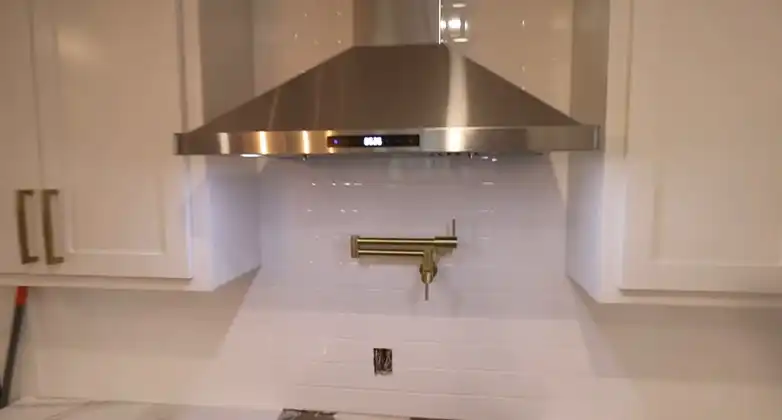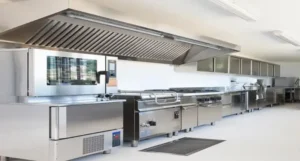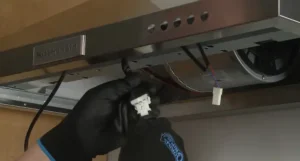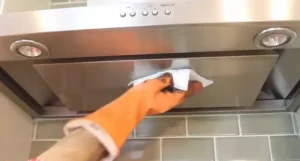If you’ve ever been in a kitchen where the air is heavy with the scent of last night’s meal or you’ve had to wave away smoke while cooking, you’ll appreciate the importance of a good kitchen ventilation system. A convertible vent hood, in this regard, can be your kitchen’s best friend. But what is a convertible vent hood?
In this comprehensive guide, we’ll discuss convertible vent hoods, exploring what they are, how they work, and why they might just be the perfect addition to your kitchen. Later on, we will provide some professional tips as well. Let’s start.

What Exactly Is a Convertible Vent Hood?
Before we dive into the specifics, let’s start with the basics. What exactly is a convertible vent hood?
A convertible vent hood is a kitchen appliance designed to remove smoke, odors, grease, and other airborne particles that are produced during cooking. What sets it apart is its adaptability, it can be configured in different ways to suit your kitchen’s specific ventilation needs.
Now, let’s break down the key aspects of convertible vent hoods, one step at a time.
How Does a Convertible Vent Hood Work?
Understanding how a convertible vent hood operates is crucial to grasp its potential benefits. There are two primary modes of operation for convertible vent hoods:
Ducted (Vented) Mode
In ducted mode, the vent hood is connected to a duct that directs the exhaust air to the outside of your building. Here’s how it works:
Air Suction
When you’re cooking, the vent hood uses a powerful fan to suck in the air laden with cooking byproducts, such as smoke, grease particles, and odors.
Duct Transport
The captured air is then transported through the ductwork, which acts as a conduit, directing the contaminated air outside your home.
Exhaust to the Outdoors
Once outside, the air is released into the atmosphere, effectively removing the cooking fumes and odors from your kitchen.
Ducted mode is highly effective at eliminating cooking odors and smoke, making it a preferred choice for many homeowners. However, it requires access to an exterior wall or roof for ducting, which can be a limiting factor in some kitchen layouts.
Ductless (Recirculating) Mode
If you can’t install ductwork or prefer a more flexible setup, the ductless mode of operation comes to the rescue. Here’s how it works:
Air Suction
Similar to ducted mode, the vent hood uses a fan to draw in the air filled with cooking byproducts.
Air Filtration
Instead of expelling the air outside, ductless vent hoods employ one or more filters (usually charcoal or carbon) to capture and purify the contaminants in the air.
Recirculation
Once the air is cleaned, it’s released back into your kitchen, now free from smoke, grease, and odors.
Ductless vent hoods are more versatile in terms of installation, as they don’t require access to an exterior wall or roof for ducting. However, it’s important to note that they may not be as effective as ducted hoods in eliminating cooking odors and smoke.
What’s the Difference Between Convertible and Other Types of Vent Hoods?
Now that you have a solid understanding of how convertible vent hoods work, let’s compare them to other common types of vent hoods. This comparison will help you decide which one is the best fit for your kitchen.
| Aspect | Convertible Vent Hood | Ducted Vent Hood | Ductless Vent Hood |
| Ventilation Modes | Can be both ducted and ductless | Only ducted | Only ductless |
| How It Vents | Vents air outside (ducted mode) or recirculates (ductless mode) | Vents air outside | Recirculates air |
| Effectiveness | Good | Excellent | Moderate |
| Installation Ease | Complex requires ductwork | Complex, requires ductwork | Easy, no ducting needed |
| Cost of Installation | Moderate | Higher due to ductwork | Lower |
| Flexibility | Highly flexible, can adapt to different kitchen setups | Limited to where ducting can be installed | Versatile, works in various kitchens |
| Professional Installation | Recommended for ducted mode | Recommended | Optional, but often DIY-friendly |
| Energy Efficiency | Energy-efficient in ductless mode | Energy-efficient | Energy-efficient |
| Air Quality Improvement | Effective in removing cooking odors and smoke | Highly effective | Moderate |
| Maintenance | Regular filter cleaning or replacement in ductless mode | Cleaning and maintenance of ductwork | Regular filter cleaning or replacement |
| Cost | Mid-range | Higher-end | Lower-end |
| Suitable Kitchen Types | Suitable for kitchens with flexible ventilation needs | Best for kitchens with access to exterior walls or roofs | Suitable for kitchens without ducting options |
| Noise Level | Variable fan speeds offer noise control | Noise level varies depending on fan speed | Variable fan speeds offer noise control |
| Installation Location Flexibility | Can be installed in various locations | Limited to where ducting can be installed | Can be installed in various locations |
Benefits of a Convertible Vent Hood
Now that you know how a convertible vent hood stacks up against other options, let’s explore why you might want to consider one for your kitchen.
Flexibility
One of the standout benefits of a convertible vent hood is its adaptability. It offers you the flexibility to choose between ducted and ductless modes of operation. This adaptability can be a game-changer when your kitchen’s layout or your ventilation needs change over time.
Easy Installation
If you opt for the ductless mode, installation is typically a straightforward process that you can tackle as a DIY project. This makes it an attractive choice for homeowners who want to improve their kitchen’s ventilation without the hassle of complex installations.
Cost-Efficient
Convertible vent hoods are often more budget-friendly than installing ductwork for a ducted hood. If you’re looking for an effective kitchen ventilation solution without breaking the bank, a convertible vent hood might be the right choice for you.
Is a Convertible Vent Hood Right for Your Kitchen?
By now, you might be wondering whether a convertible vent hood is the right fit for your kitchen. Let’s break down when and why you should consider installing one.
You should strongly consider installing a convertible vent hood if:
You Want Fresh, Odor-Free Air
If you’re tired of your kitchen smelling like your latest culinary experiment, a vent hood can help keep the air fresh and free from lingering cooking odors.
You Have the Option for Ducted or Ductless Installation
Convertible vent hoods are a versatile choice, offering both ducted and ductless modes of operation. This means you have options, even if you can’t install ductwork.
You’re Looking for a Cost-Effective Ventilation Solution
Convertible vent hoods are often more budget-friendly than the alternatives, especially if you opt for ductless installation.
When Should You Install It?
The timing for installing a convertible vent hood depends on your specific situation. Here are some scenarios when you might want to consider installation:
During Kitchen Remodeling
If you’re planning a kitchen remodel or renovation, it’s an ideal time to install a vent hood. This way, you can seamlessly incorporate it into your new kitchen design.
When Cooking Odors Become a Problem
If you find that cooking odors are taking over your kitchen and home, it’s a sign that it’s time for better ventilation.
As an Upgrade
Maybe you’re simply looking to upgrade your cooking experience. A vent hood can improve air quality, making your kitchen more comfortable and enjoyable to cook in.
People Also Ask
Can I Install a convertible vent hood Myself?
Yes, you can install a convertible vent hood yourself, especially if you’re going for ductless installation. However, for ducted installation, it’s advisable to seek professional help, especially if you’re not experienced with ductwork.
How Often Should I Clean the Filters?
If you’re using a ductless vent hood, clean or replace the filters every 3-6 months, depending on your usage and the manufacturer’s recommendations. Clean filters ensure efficient air purification.
Are Convertible Vent Hoods Noisy?
Convertible vent hoods can produce some noise due to the fan’s operation. However, most models come with multiple fan speed options. So, you can choose a quieter setting for regular use if it’s too noisy for your home.
In Summary
A convertible vent hood is a versatile and practical addition to any kitchen. It offers the flexibility to adapt to your kitchen’s layout and your ventilation needs. Whether you choose ducted or ductless mode, a convertible vent hood can help keep your kitchen smelling fresh, improve air quality, and make your cooking experience more enjoyable.
So, if you’re tired of your kitchen being overwhelmed by cooking odors and smoke, or you’re simply looking to upgrade your kitchen’s ventilation, consider installing a convertible vent hood. It might just be the perfect solution to keep your kitchen air clean and your home smelling fresh. Your nose and your taste buds will thank you!



